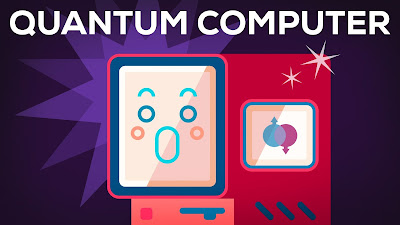For most of
our history, human technology consisted of our brains, fire, and sharp sticks.
While fire and sharp sticks became power plants and nuclear weapons, the
biggest upgrade has happened to our brains. Since the 1960’s, the power of our
brain machines has kept growing exponentially, allowing computers to get
smaller and more powerful at the same time. But this process is about to meet
its physical limits. Computer parts are approaching the size of an atom! To
understand why this is a problem, we need to clear up some basics.
Quantum
computer is that computer which does its entire works using quantum mechanics.
It uses Entanglement, Teleportation, and Superposition etc to compute or
exchange information. Quantum computers can do such things that cannot be done
using normal computers. But the fact is, Quantum computer cannot still be developed
in the laboratory.
 |
| Quantum Computer |
A computer is made up of very simple
components doing very simple things. Representing data, the means of processing
it and control mechanisms. Computer chips contain modules, which contain logic
gates and transistors. A transistor is a simplest form of a data processor in
computers. Basically, it’s a switch that can block, or open the way for
information coming through. This information is made up of bits which can be set
either 0 or 1. Combinations of several bits are used to represent more complex
information. Transistors are combined to create logic gates which still do very
simple stuff. For example, an AND gate sends an output of 1 if all of its
outputs are 1, and an output of 0 otherwise. Combination of logic gates finally
forms a meaningful module, for adding two numbers. Once you can add you can
also multiply, and once you can multiply you can basically do anything. Since
all basic operations are literally simpler than fist grade math, you can
imagine a computer as a group of little kids answering really basic math
questions. A large enough bunch of them could compute anything.
However with
parts getting tinier and tinier, quantum physics are making things tricky. In a
nutshell a transistor is just an electric switch. Electricity is moving
electrons from one place to another. So, a switch is a passage that can block
electrons from moving in one direction. Today a typical scale for transistors
is 14 nanometers. Which are about 8 times
less than HIV virus’ diameter, and 500 times smaller than red blood cells. As
transistors are shrinking to the size of only a few atom, electrons may just
transfer themselves to the other side of a blocked passage via a process called
Quantum tunneling. In a quantum realm, physics works quite differently from the
predictable ways we’re used to, and traditional computers just stop making
sense. We are approaching a real physical barrier for our technological
progress. To solve this problem, scientists are trying to use these unusual
quantum properties to their advantage by building quantum computers.
Qubits
In normal computers, bits are the
smallest unit of information. Quantum computers use qubits which can also be
set to one of two values. A qubit can be
any two level quantum systems, such as a spin and a magnetic field, or a single
photon. 0 and 1 are this system’s possible states, like the photons horizontal
or vertical polarization. In the quantum world, the qubit doesn’t have to be
just one of those; it can be any proportions of both states at once. This is
called superposition. But as soon as you test its value, by sending the photon
through a filter, it has to decide to be either vertically or horizontally
polarized. So, as long as it’s unobserved, the qubit is in a superposition, of
probabilities for 0 and 1, and you can predict which it’ll be. But the instant
you measure it, it collapse into one of the definite states. Superposition is a
game changer. Four classical bits can be one of two to the power of four
different configurations at a time. That’s 16 possible combinations, out of
which you can use just one. Four qubits in a superposition, however, Can be all
of those 16 combinations at once. This number grows exponentially with each
extra qubit. Twenty of them can already store a million values in parallel.
Entanglement
A really weird and unintuitive
property qubits can have is Entanglement. It is a close connection that makes
each of the qubits reacts to a change in the other’s state instantaneously, no
matter how far they are apart. This means when measuring just one entangled
qubit, you can directly deduce properties of its partners without having to
look.
A normal
logic gate gets a simple set of inputs and produces one definite output. A
quantum gate manipulates an input of superposition, rotates probabilities, and
produces another superposition at its output. So, a quantum computer sets up some
qubits, applies quantum gate to entangle them and manipulate probabilities,
then finally measures the outcome, collapsing superposition to an actual
sequence of 0’s and 1’s. What this means is that you get the entire lot of
calculations that are possible with your setup, all done at the same time.













0 comments:
Post a Comment